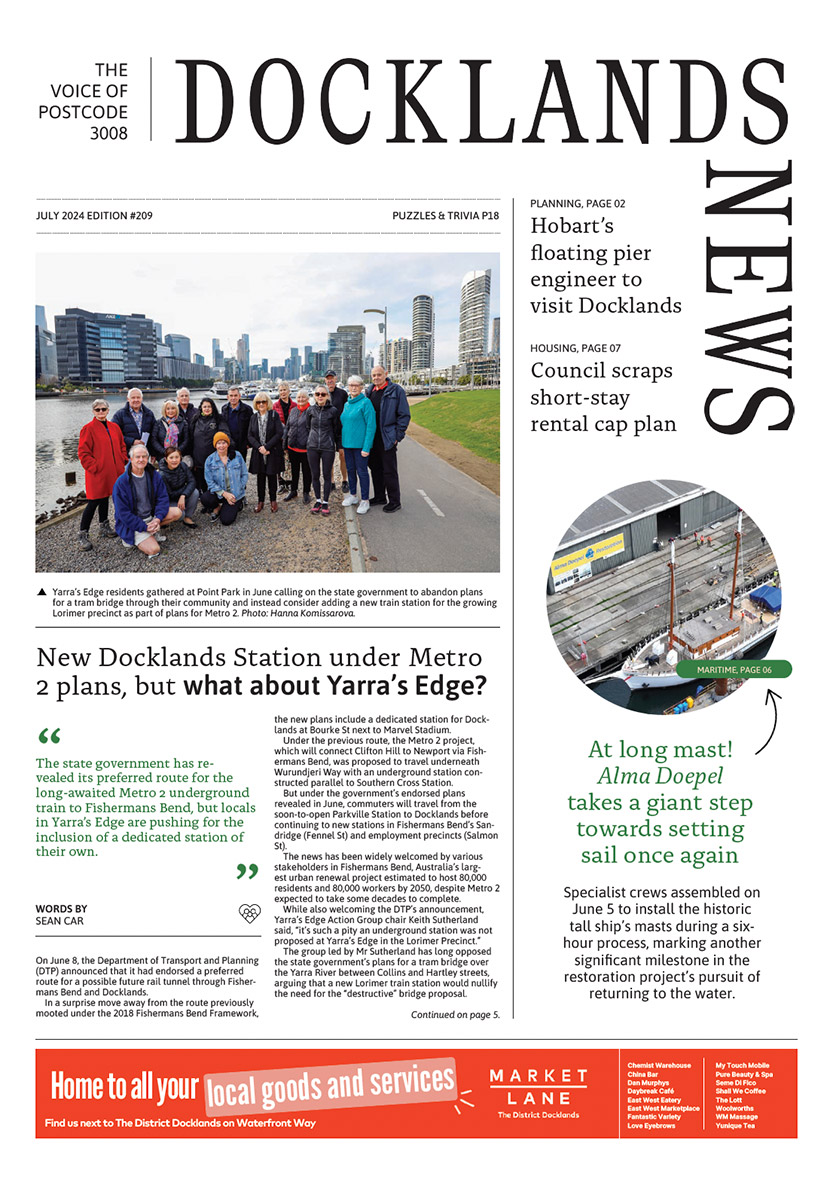Harbour beautification and small-scale activations on the cards for Docklands
The City of Melbourne has prioritised a long list of projects to help reinvigorate the Docklands precinct with immediate harbour beautifications and a community events space along Harbour Esplanade being proposed.
The potential new projects – which include advocacy for the redevelopment of Central Pier, delivery of the shopfront activation program, Greenline, and the events partnership program – were put forward after councillors endorsed the Docklands Summit “actions and next steps” at their November 8 Future Melbourne Committee meeting.
The Docklands Summit was a half-day event held on September 2, which consisted of presentations by key stakeholders and workshops to “elevate the urgent need and generate enthusiasm and outcomes for regeneration in Docklands” after it was heavily impacted by the pandemic.
A 38-page “What was said” report was compiled by the council and published on the Participate Melbourne website following the summit, which detailed ideas and aspirations to revitalise the Docklands precinct.
In endorsing the Docklands Summit, the council will now consider a range of project items in the short, medium and long term (subject to future council budget and resource planning) including:
- Undertake immediate beautification and wayfinding improvements around Victoria Harbour, Harbour Esplanade, NewQuay and Yarra’s Edge, including planter boxes, public benches, public artwork and additional greening.
- Partner with Development Victoria (DV) to deliver physical improvements and a program of small-scaled activations to Yanonung Quay (the new name for the ferry terminal at Victoria Harbour).
- Ensure communications celebrate Docklands and promote events that align with Docklands as a family friendly precinct.
- Partner with DV to review the operational capacity of existing community facilities and identify opportunities for improvements.
- Prepare a public realm improvements plan to review the current provision of amenities and identify areas for improvements and activations.
- Create a strategic plan for Docklands, partnering with the state government to ensure cross-government support to review “sub-precinct character and identity”.
- Establish a Docklands governance review group with the state government.
Addressing the council meeting, Deputy Lord Mayor Nicholas Reece said the summit was the “reset that was needed in terms of energy and focus thinking” to ensure “Docklands delivers on its potential as one of Melbourne’s and one of Australia’s most amazing suburbs”.
In terms of the council’s priority projects, Cr Reece said it would be “doubling down” on its efforts to work with Development Victoria in redeveloping Central Pier, which he described as an “absolute must for Docklands”.
“It’s such an asset with such potential and yes, it must be fixed,” he said.
Cr Reece also said Yanonung Quay could become “a world-famous location” in Melbourne as well as Australia’s busiest commuter port by 2030 when Melbourne is predicted to overtake Sydney as the nation’s largest city.
Overall, Cr Reece said the future of Docklands was exciting, and while the council would consider its budget deliberations he believed “there’s a very big gain to be made from a modest investment”.
Other projects in the pipeline include exploring a space to display heritage vessels as part of Central Pier and Harbour Esplanade redevelopment, identifying opportunities to celebrate Aboriginal and maritime heritage, and finding new landscaping opportunities and upgrades.
A reconnection of the Moonee Ponds Creek trail, supporting water-based events, and working with DV to plan for “future community infrastructure” as part of addressing short-term demand will also be pushed.
The council will continue working with the Docklands Chamber of Commerce to support local businesses and hoped to review extending the Docklands Dollars program.
Docklands Chamber of Commerce executive officer Shane Wylie said while beautification and activation of Harbour Esplanade was an “easy short-term win for all” and would promote visitation, he questioned why it had taken three years of community advocacy and a summit to achieve.
“Long-term collaboration and a strategy acknowledging that Docklands needs an aligned vision is one of the most important outcomes of the summit,” he said. “One of the issues that we, traders, event managers and developers have had is the number of authorities that Docklands has.”
A Docklands Representative Group spokesperson said document was primarily aimed at increasing visitation to Docklands with little focus on residents.
“It is very telling that this document mentions ‘events’ 18 times, ‘activations’ 15 times, and ‘residents’ once,” the spokesperson said.
“It is also very disappointing that the statistics about residents, in particular the vacancy rates, shared at the summit were a year out of date with no source stated.
“Despite repeated requests to City of Melbourne, they have not explained why they used a vacancy rate of 42 per cent when the current Docklands residential vacancy rate is very low. The question is, why did they paint such a negative picture of the residential situation in Docklands?”
A Docklands Representative Group spokesperson said the document was primarily aimed at increasing visitation to Docklands with little focus on residents.
In its submission to the report, Docklands Neighbourhood House (DNH) said it while it was in “absolute agreement” that adequate resourcing was required, it said investment in Docklands in recent years hadn’t so much been the issue, but rather how it had been made.
“We implore the council to not fall into the traps of the past and only fund ‘big ticket’ infrastructure projects,” its submission said.
“Whilst these may assist in finding the ultimate equilibrium for Docklands, the City of Melbourne must also ensure the resourcing of community-focused plans and projects. Docklands Summit, City of Melbourne’s neighbourhood study and DNH’s own research demonstrate this vital investment.”
Cr Jamal Hakim, also a Docklands resident, said the council’s actions and next steps were “only the beginning” and the approach “truly requires active participation and collaborative collaboration”.
The findings from the summit were also incorporated in the Neighbourhood Portal, which Cr Reece said was “a wonderful new platform” to “help knit the community together”. •

New Docklands Station under Metro 2 plans, but what about Yarra’s Edge?








 Download the Latest Edition
Download the Latest Edition